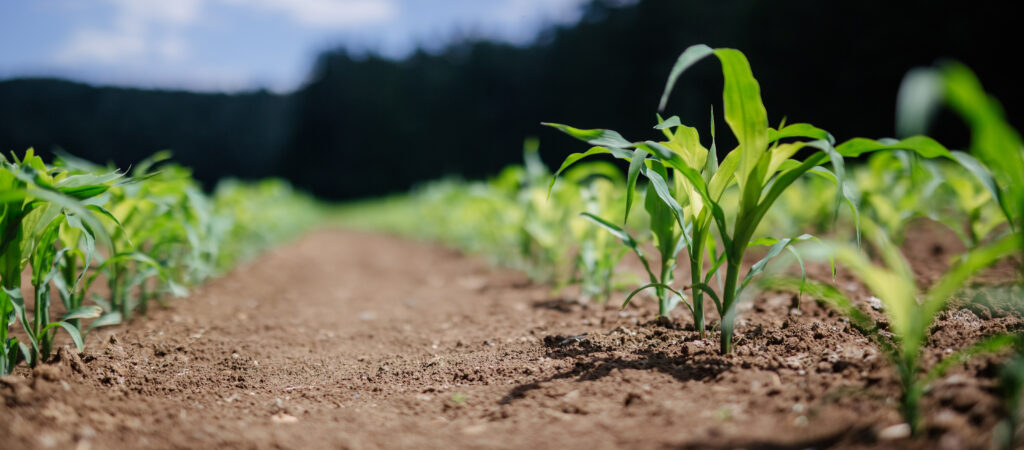A discussion between Shin Furuya, our Director of Impact Strategy and in-house expert on the future of food, and Mary Cobble, an Investment Analyst at Domini

Despite the rapid changes and new advancements happening around us, one cornerstone of our society feels like it has failed to keep pace: our food systems. One in ten people worldwide suffer from hunger, while one in three lack regular access to adequate food1. Still, a whopping 30% of global food production becomes food waste2. With the world’s population expected to reach nearly 10 billion3 by 2050, we are at a critical tipping point that requires a true reimagination of how we feed our population.
Let’s narrow in on today’s agricultural industry and how it affects forests, soil, and climate change. At Domini, we believe that no system works separately from the rest of our economy and planet, and our modern food systems are no exception. Half of the world’s habitable land is currently used for agriculture4, and consequently, agriculture and its contingent practices have become the single greatest5 cause of deforestation and land degradation worldwide. Our solutions, then, must be interconnected as well.
The movement for better farming is underway, and we’ve already seen an increase in the adoption of more sustainable approaches, like the use of organic fertilizers and rainwater recycling. Now, some of the most significant innovation involves regenerative agriculture and urban farming, among other methods, which could help prevent further deforestation and help adapt to the effects of climate change. If we are to rethink our food systems, these solutions and their implications are crucial to understand, both as consumers and as investors.
The Domini team often turns to our Director of Impact Strategy, Shin Furuya, when we need someone to break down a complex topic. He’s very familiar with the food and agricultural solutions that have emerged over the past twenty years. As an Investment Analyst here at Domini—responsible for analyzing the food industry market—I wanted to discuss with Shin the delicate relationship between our food, our forests, and our future.
Mary: Shin, can you explain the link between deforestation and the food we buy?

Shin: Forests play an extremely important role in our global ecosystem. They reduce soil erosion, improve water retention, and can even physically protect the land from rain, wind, or flooding. Forests also foster a wealth of biodiversity by providing an ideal habitat for critical agricultural players like pollinators or pest-killing natural predators.
Additionally, forests help keep soil in its most suitable condition for food production. They clean nitrogen oxide from the air and regulate the biogeochemical cycle of nitrogen, which is critical to soil health. Deforestation can lead to rising levels of nitrogen oxide, causing serious damage to crops, and subsequently, crop sales.
Mary: Climate change is also in the mix. How do forests and food production affect our climate—for better or for worse?
Shin: Old-growth forests, along with the plants and soil beneath them, can act as one of the most powerful carbon storage systems on terrestrial earth, capable of absorbing almost 30% of annual human-caused greenhouse gas emissions (GHGs). This feature alone plays a crucial role in regulating our climate.6
Agricultural yields rely on stable climate and weather patterns. But, the irony is, decades of carbon-intensive, industrial agricultural practices focused on maximizing yield have damaged climate systems and exacerbated extreme weather events—which, in turn, have forced frequent disruptions and continual yield declines in many countries. These practices have also destroyed biodiversity, forests, and soil, all of which are critical agricultural safeguards against the kinds of extreme weather we have already started to witness.
Mary: Now I want to hone in more on food and farming. How is the agricultural industry responding to its environmental challenges? Are there any particular trends and innovations that stand out to you?

Shin: Population growth means there will be a large increase in the demand for food products in the coming decades. Climate change, pollution, and disturbances to the soil suggest that crop yields will only continue to fall. On top of all this, arable land has been declining each year—due to the residential and commercial development that accompanies population growth. This global threat to food security amounts to an enormous, unprecedented challenge. Large-scale, industrial agriculture’s practices are entangled in its roots.
As a result, the industry is waking up and starting to respond. We’re seeing growth in regenerative agriculture, also referred to as “carbon farming.” This is a process where soil is not tilled. Instead, various techniques—managed animal grazing, use of compost, and, most often, planting a cover crop—are used to keep more nutrients in the soil. Regenerative agriculture not only preserves the quality of the soil, but also increases water storage and reduces the amount of GHGs released into the atmosphere.
Another emerging trend that has gained popularity is the practice of urban, vertical, indoor farming. It’s a valuable solution, especially as arable land dwindles. Geographically, it makes a lot of sense to produce food close to customers, which significantly reduces the carbon footprint and costs associated with transportation. Vertical farms have the potential to yield more per acre than conventional farms. Their being indoors in a controlled environment protects crops from adverse climate conditions and increases the predictability of crop yields. As this innovation becomes more widely adopted, we need to ensure that vertical farms use renewable energy and green technology to offset their carbon footprint coming from the use of less clean technologies.
Mary: Can you give a little background on the roots of regenerative agriculture?
Shin: What’s fascinating is that while large food companies somewhat recently started to promote regenerative agriculture as a new trend, Indigenous Peoples have been practicing this method for thousands of years. Lately, what began as a shift back towards organic farming has really broadened into regenerative farming practices—with growers and companies realizing they need to do more for the restoration of the soil and surrounding ecosystems, and for the resiliency of their farms and communities. But again, this “innovation” is in effect a return to traditional and more holistic agricultural methods.
Mary: What does progress look like for food companies that rely on agricultural supply chains?
Shin: There is a growing awareness among agricultural professionals, experts, and food production companies that agriculture must consider more than the narrow, short-term pursuit of yield and profits. Farmers can’t be the only ones to shoulder burden. Carrying on “business as usual” will only continue to threaten farmers’ livelihoods while also affecting the long-term value creation ability of companies. To achieve such ambitious goals, these companies need to set multi-year, forward-looking, maybe even timebound targets in order to successfully integrate new agricultural practices and sustainable solutions for their supply chains.
Mary: Are there specific kinds of company-level goals that we’re starting to see?
Shin: Already, there have been some encouraging improvements. A growing number of food companies have started to support farmers within their respective supply chains to incorporate organic and regenerative agriculture, while others have managed to get over half of their products produced with organic or non-GMO produce. While the majority of companies may take years to reach this 50% threshold, even incremental changes can protect farmers’ future revenues and product resiliency.
Mary: Of all the developments related to the food system, what makes you the most optimistic?
Shin: For a long time, key stakeholders weren’t really coming together to acknowledge the seriousness of the challenges we’re facing. That’s progressively changing. This shared awareness, combined with climate-conscious regenerative agriculture, feels like a huge step.
Some have raised concerns that regenerative agriculture might yield less food than traditional practices—but there’s huge potential for increased profitability and consistency in production due to the significant reduction in input costs and strategic crop diversification. An increase in knowledge-sharing, too, has been pivotal, allowing farmers to share critical data reflecting their experiences to help make better decisions regarding farms’ daily operations.
Mary: We’ve covered a lot of ground. How would you wrap it up?
Shin: At the end of the day, if we don’t change, the Earth will force us to—and with likely catastrophic consequences. Now, more than ever, we must find resilience to persevere through the climate crisis while ensuring access to affordable food, and not just through a single approach. Our sustainable solutions around food production and food security must stem from shared critical ways of thinking, inspired by practices of the past and visions of the future. We have the knowledge, the tools, and the motivation to change how we feed the world. We owe it to future generations—and to our natural world—to put it all together and make a difference.
